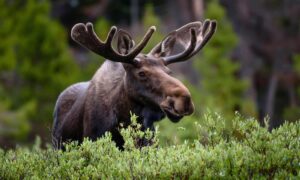
One morning in the winter of 1978, a handful of state wildlife staff huddled together in the Uinta Mountains in north-eastern Utah. Deep snows coated the peaks and filled the valleys. A pair of helicopters cruised over the frozen landscape, helping those on the ground search for their prize: a cow moose in a snowy meadow.
Crouched in one of the aircraft, a man aimed his rifle: there was a sharp report, and the cow took off at a run. Within minutes her legs went wobbly as the tranquilliser in the dart took effect, and the crew landed and got to work.
They tagged and collared the moose, then slid a specially designed sling under her belly, attached by a rope to one of the helicopters. For a moment, as the pilot eased into the air, the moose lurched, drawing her legs upward as her feet left the ground.
But then the animal appeared to relax as she soared over the rugged valley, bound for her new home more than 200 miles away in Colorado’s North Park region near Walden– a vast expanse of sagebrush and willow between two mountain ranges.
Few creatures evoke the American wilderness like Alces americanus, the American moose. It is the second-largest land animal in North America, behind the bison. Its imposing size is undercut by a goofy countenance – the wide fan of horns, thin legs that suspend a hefty body and a face like a hand- puppet fashioned from a worn-out sock.
Despite their ungainly appearance, however, moose are formidable and sometimes graceful, reaching speeds of 35mph at full gallop. Over time, in Colorado, the moose has emerged as a potent symbol and ambassador of the wild in a state enamoured of its outdoor places, depicted in murals and statues in many mountain towns.
But as much as Alces americanus seems to belong in Colorado, its native range does not extend into the state. Colorado’s wildlife department introduced moose in the 1970s to help generate revenue through the sale of hunting licences. In that era of wildlife management, the decision of a few high-ranking state officials was enough to set a great ecological experiment into motion.
“We brought them to Colorado because we could,” said the late Gene Schoonveld, a biologist at the forerunner to Colorado Parks and Wildlife, who was among the officials to set the translocation in motion (Schoonveld died in 2022). “We had the space and the habitat for them.”
